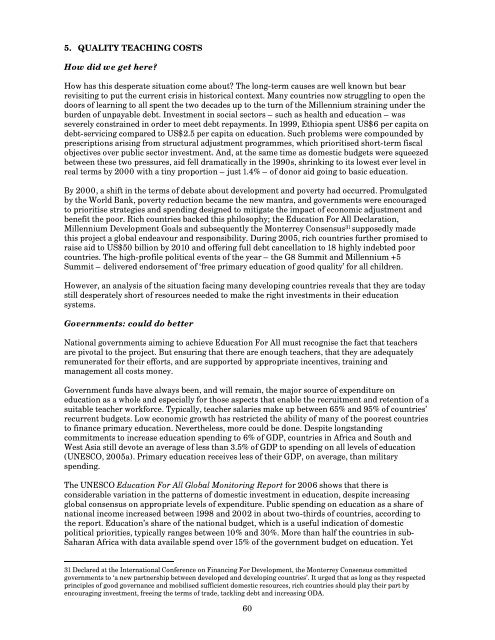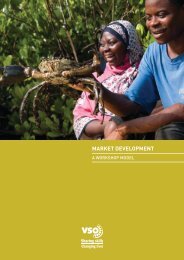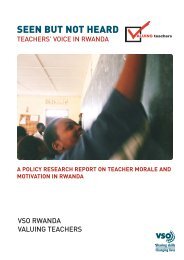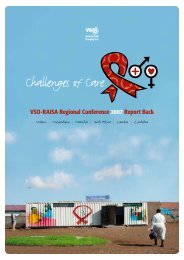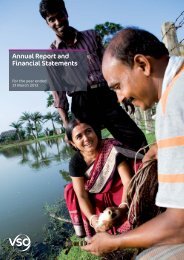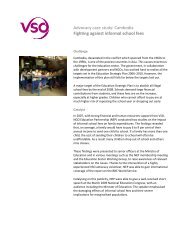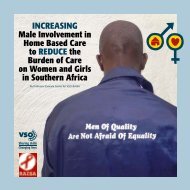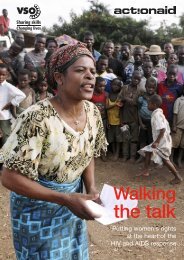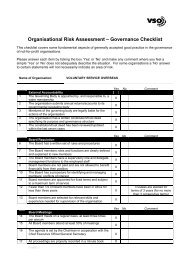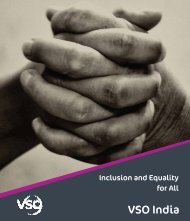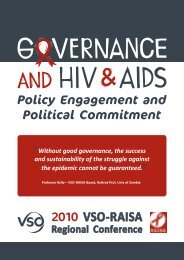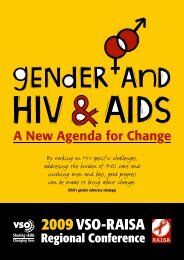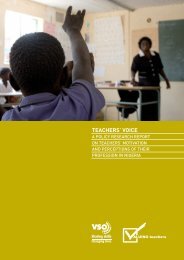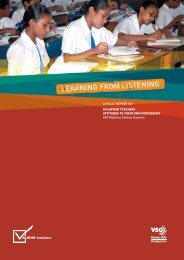Teachers for All â GCE policy briefing (566KB) - VSO
Teachers for All â GCE policy briefing (566KB) - VSO
Teachers for All â GCE policy briefing (566KB) - VSO
Create successful ePaper yourself
Turn your PDF publications into a flip-book with our unique Google optimized e-Paper software.
5. QUALITY TEACHING COSTSHow did we get here?How has this desperate situation come about? The long-term causes are well known but bearrevisiting to put the current crisis in historical context. Many countries now struggling to open thedoors of learning to all spent the two decades up to the turn of the Millennium straining under theburden of unpayable debt. Investment in social sectors – such as health and education – wasseverely constrained in order to meet debt repayments. In 1999, Ethiopia spent US$6 per capita ondebt-servicing compared to US$2.5 per capita on education. Such problems were compounded byprescriptions arising from structural adjustment programmes, which prioritised short-term fiscalobjectives over public sector investment. And, at the same time as domestic budgets were squeezedbetween these two pressures, aid fell dramatically in the 1990s, shrinking to its lowest ever level inreal terms by 2000 with a tiny proportion – just 1.4% – of donor aid going to basic education.By 2000, a shift in the terms of debate about development and poverty had occurred. Promulgatedby the World Bank, poverty reduction became the new mantra, and governments were encouragedto prioritise strategies and spending designed to mitigate the impact of economic adjustment andbenefit the poor. Rich countries backed this philosophy; the Education For <strong>All</strong> Declaration,Millennium Development Goals and subsequently the Monterrey Consensus 31 supposedly madethis project a global endeavour and responsibility. During 2005, rich countries further promised toraise aid to US$50 billion by 2010 and offering full debt cancellation to 18 highly indebted poorcountries. The high-profile political events of the year – the G8 Summit and Millennium +5Summit – delivered endorsement of ‘free primary education of good quality’ <strong>for</strong> all children.However, an analysis of the situation facing many developing countries reveals that they are todaystill desperately short of resources needed to make the right investments in their educationsystems.Governments: could do betterNational governments aiming to achieve Education For <strong>All</strong> must recognise the fact that teachersare pivotal to the project. But ensuring that there are enough teachers, that they are adequatelyremunerated <strong>for</strong> their ef<strong>for</strong>ts, and are supported by appropriate incentives, training andmanagement all costs money.Government funds have always been, and will remain, the major source of expenditure oneducation as a whole and especially <strong>for</strong> those aspects that enable the recruitment and retention of asuitable teacher work<strong>for</strong>ce. Typically, teacher salaries make up between 65% and 95% of countries’recurrent budgets. Low economic growth has restricted the ability of many of the poorest countriesto finance primary education. Nevertheless, more could be done. Despite longstandingcommitments to increase education spending to 6% of GDP, countries in Africa and South andWest Asia still devote an average of less than 3.5% of GDP to spending on all levels of education(UNESCO, 2005a). Primary education receives less of their GDP, on average, than militaryspending.The UNESCO Education For <strong>All</strong> Global Monitoring Report <strong>for</strong> 2006 shows that there isconsiderable variation in the patterns of domestic investment in education, despite increasingglobal consensus on appropriate levels of expenditure. Public spending on education as a share ofnational income increased between 1998 and 2002 in about two-thirds of countries, according tothe report. Education’s share of the national budget, which is a useful indication of domesticpolitical priorities, typically ranges between 10% and 30%. More than half the countries in sub-Saharan Africa with data available spend over 15% of the government budget on education. Yet31 Declared at the International Conference on Financing For Development, the Monterrey Consensus committedgovernments to ‘a new partnership between developed and developing countries’. It urged that as long as they respectedprinciples of good governance and mobilised sufficient domestic resources, rich countries should play their part byencouraging investment, freeing the terms of trade, tackling debt and increasing ODA.60


